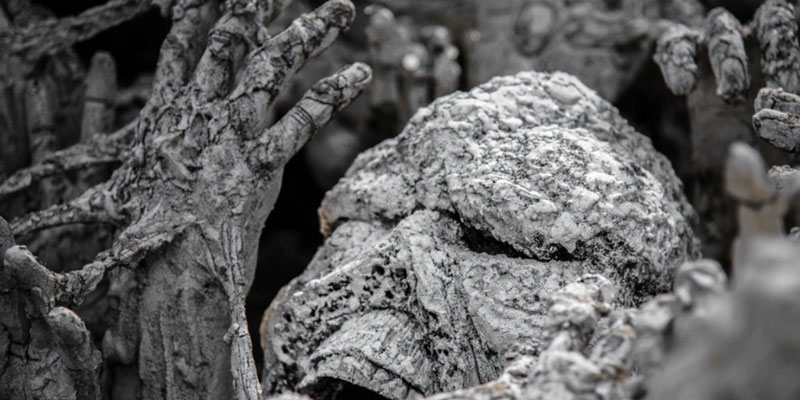I’m honestly baffled that a coalition of “open government organizations” would call on Democrat Governor Dan McKee to reinstate executive orders allowing government bodies to meet remotely again:
We therefore once again strongly urge you to reinstate your earlier executive orders so as to permit public bodies to meet virtually and thereby allow the public to monitor and, where authorized, participate in those meetings remotely. The discouraging and admittedly tiring length of time that we have all had to deal with the effects of Covid demands more, not less, attention to ensuring public oversight of the democratic process.
We’d be better off mandating that government be completely closed down except for vital services.
COVID-driven remote meetings set open government back decades in Rhode Island, made it much more difficult to hold government officials accountable, and put a huge wet blanket on public participation. From my experience, this has been so obvious that one almost has to conclude that activists are manipulating ACCESS/RI to advance the complete antithesis of what they claim to support.
The media people on the list, like Scott Pickering of the East Bay Media Group and Ethan Shorey of the Valley Breeze, are perhaps well meaning and only hoping to make their employees’ lives easier. However, those with any experience advocating for issues, like Steven Brown of the RI ACLU and John Marion of Common Cause RI, should see the manifest problems.
Sure, it would be great if all meetings had to be live-streamed, recorded, and made available in streamable online archives for on-demand viewing. But allowing elected officials to go back to the near-complete situational control of participating in public meetings as if they were corporate staff meetings is a recipe for corruption.
Having the power, with the click of a button, to completely silence undesired speakers (as if they no longer existed) and easily enforce the most strict and unreasonable time limits, while preventing the need to endure so much as a tense room, is every corrupt official’s dream. Open government groups ought to be the most concerned organizations about this step, not its lead advocates, which makes you wonder where their sympathies actually lie.
Featured image by Justin Katz.
[Open full post]This isn’t exactly a difficult political opportunity to identify, but it’s fun to wonder whether somebody on Seth Magaziner’s campaign team listened to my weekly segment with John DePetro, yesterday:
We must address the dangerous hospital staffing shortage that has created a state of crisis in emergency rooms and other care delivery facilities across the Rhode Island.
Today, I proposed the following measures to address the emergency room staffing shortage…
He goes on to list precisely the sort of steps the state should be taking (rather than trying to put residents in a mandatory bubble) to alleviate healthcare provider shortages.
The caveat (naturally) is that our agreement is only on the short term. Magaziner’s a progressive, so with a horizon past the political opportunity of an immediate crisis, I’m sure his preferred policies remain of the sort that destroy nations.
[Open full post]I was perfectly comfortable receiving the Pfizer vaccine against COVID. I investigated how they work and reviewed the numbers, and decided it made sense. Since I wrote that post in May, however, public health authorities and those who’ve put them on a pedestal have continued to sound like pitchmen rather than scientists, which has made me increasingly reluctant to follow their advice.
Most confoundingly, a level or two down from the experts in the range of informed citizens, people are sharing pro-vaccination stories that even advocates should see through. One such person recently shared a CNBC article by health and wellness reporter Cory Stieg. The headline this person was promoting is pretty nearly a lie: “Natural immunity doesn’t protect you as well as the Covid vaccines — here’s why.”
The article does not support that assertion in the least. It’s clickbait. The most Stieg can claim is:
If you’ve recovered from Covid, you do have a degree of immunity against the virus — but the amount can vary significantly, based on the severity of your illness and how long ago you recovered.
Currently, there’s no known way to test your immunity levels.
Well, duh. But if “there’s no known way to test your immunity levels,” doesn’t that apply to vaccines, too? Of course it does. That’s why such matters are judged through experiments and statistical analyses, and statistically, natural immunity is better. Indeed, as I’ve pointed out, the confusion comes from the fact that public health authorities are counting anybody in whom the most-sensitive test is finding any trace of COVID as a “case.” The more reasonable conclusion is that they don’t have immunity because they weren’t really infected. (And yes, that means the scare numbers of cases, hospitalizations, and deaths are dramatically overblown.)
The failure of experts to lead the way in a reasoned and honest presentation of the facts justifiably increases skepticism in the public even of things that prove reasonable when investigated. By the numbers, three circumstances are roughly equal when it comes to determining that you’re of reduced risk:
- One, if you’ve had COVID, especially if you’ve actually had it, rather than simply testing positive after being identified through contact tracing
- Two, if you’ve been vaccinated
- Three, if you’re young
Sure, none of these factors cancel out, so the person at the least risk, which means almost no risk at all, is the one who fits in all three categories, but the incremental benefit is fractional and well within the range of what a reasonable public health regime ought to leave to the individual, particularly when there’s any risk at all of side effects from the vaccines.
Unfortunately, we’re not being governed or guided by a reasonable public health regime, but a fleet of vaccine salespeople swept up in an ideological campaign.
Featured image by the CDC on Unsplash.
[Open full post]The question derives from New Neo suggesting that thinking installing a figurehead president would simply leave the country to run itself was “hubris squared.” Is that hubres?
Our elites stoked a sense of panic to seize control, with this underlying reality:
Whether or not you think Biden won fair and square in 2020 or because of fraud, it hardly matters to the point I’m attempting to make. The reality is that millions of people voted for a man who was not up to the task, and they rejected the man who had been doing a relatively good job by the usual objective measures.
One of the reasons they talked themselves into doing this was that they did not think it necessary to have any skills to be president – and by “skills,” I mean any record of having made good decisions in forty or so years of public service. They seem to have thought that a country like the US flew on automatic pilot and would go about without much guidance, and that is, just as long as Democrats held power.
And indeed, those Democrats didn’t have to be chosen for skills or track records, either. People could choose these Democrats because they were “progressive” and checked certain demographic boxes. Kamala Harris and the rest of Biden’s Cabinet are prime examples.
You can see this at every level. Qualification for office seems no longer to matter. Only holding seats for progressives.
[Open full post]The evolution of online information technology companies is a lesson in the importance of first principles.
Only recently has the convenience of cloud technology become so overwhelming in some activities that I’ve been giving in to it in a more-general way, and the temptation is always there to make it central. The idea, which has been around for more than a decade, of treating your computer essentially as a terminal to access applications and files that exist on some server, somewhere, is attractive, but worrying.
Sure, it’s great to be able to access and modify the same file from your home computer, a tablet, a cell phone, a smartwatch, or whatever. One as-yet-underappreciated benefit is that this approach allows you diversify your devices to conform with your life. You don’t have to find the sweet spot between power and portability in a single laptop that you bring out with you and still do computationally heavy tasks while in the office. You can have the super-powerful desktop at home and a (relatively) inexpensive and super portable device to carry around that still allows you to access and (to a lesser degree) modify your files.
But here’s the first principle: Maximize your ownership of anything that is important to you.
Just so, Stephen Green warns us that “‘the cloud’ is just a fancy way of saying ‘someone else’s hard drive.'” This is in response to a more-detailed warning from Tom Pritchard that Google is modifying its Google Drive policies in ways that will bring your cloud computing a little closer in nature to your social media accounts:
The search giant has announced a new policy that will restrict access to files violating its policies, and prevent them from being shared in the process.
Google announced this change in a blog post, revealing that restrictions may be put in place on files that violate Google’s Terms of Service or abuse program policies. While the owner will still have full access, this move means sharing privileges will be revoked — even if someone already has a link.
According to Google file owners will receive an email when files are restricted. Not only does that alert them to the fact it’s happened, it will also give them the opportunity to appeal the decision and request a review.
Repeat offenders could face more catastrophic loss of access.
Already if you build your whole audience-communication network on Twitter, and you may find it taken away in an instant, with no notice and with a vague, often-hopeless appeals process. Soon, you may find that state of affairs applying to any home, community, or business structure you build around a cloud service. Brother Google will have its bots constantly sifting through your data looking for unacceptable content and, without implicating the civil rights observed by government authorities, taking punitive, disruptive action. To be sure, we can expect that those government authorities will be involved when Google thinks it desirable, creating a de facto loss of First Amendment rights.
As Google closes its slow-motion trap, we all must adjust our behavior so that we can continue to profit from the advantages while maintaining escape hatches. First step is to get off Google Drive. Plenty of other services accomplish the same things without the creepiness and with the incentive to provide an alternative. Second, for any drive service, make sure you’re syncing to a hard drive. That may be minimal protection if the company can sync a delete, so to speak, but it’s something, especially if, third, you set up a separate system to backup files for real on your own devices.
Featured image by Mitchell Luo on Unsplash.
[Open full post]Here’s an interesting finding from Heritage, which prompted 2,000 rabbis to call for an end to DEI programs on campuses:
The Heritage Foundation researchers reviewed the Twitter feeds of 741 DEI officials at 65 different U.S. universities to determine their attitudes on Israel and China. They found that DEI staff “tweeted, retweeted, or liked almost three times as many tweets about Israel as tweets about China.” Of the tweets in question, 96 percent were critical of Israel, and 62 percent of the China-centered tweets were favorable. In many cases, Jews were criticized for their support of Israel and referred to as “Nazis” and “colonizers.”
While DEI staff are primarily tasked with creating a welcoming space on campus and protecting the student population, their obsession with Israel and Jews indicates they put liberal politics first. The study was released amid a soaring number of anti-Semitic attacks on college campuses that have put the Jewish community on high alert.
One wonders what researchers would find if they attempted to measurer anti-Americanism!
The whole “diversity” and “tolerance” push is a scam designed to co-opt resources meant for noble purposes (often with direct or indirect taxpayer backing) in order to push a vicious and radical ideology. This observation is too clear to deny, which is why those who support it either ignore criticism or use rhetorical tricks and bullying to recast it as a good thing (to wit, saying it’s “anti-racist” or “against white supremacy”).
[Open full post]In separate incidents, Woonsocket arrested two 12 year olds. The photo accompanying Lauren Clem’s Valley Breeze article is worth a glance. It shows a child being led away in handcuffs by a much larger police officer while another carries his backpack.
One of the children (although I don’t know whether it was this one) involved a student “overheard making threats against the school.” As usual, we get no details about what he said, but he now faces that catch-all charge of “disorderly conduct.”
The other student supposedly posted somewhere on social media that he had a knife and could get a gun. Again, we go from zero to sixty in a split second. Because he did have a knife on school grounds, he’s been charged with “possession of a prohibited weapon.” And again, we get no details about the knife, whether it was a small Swiss Army knife or a large hunting blade. We’re left to wonder whether that makes a difference.
Another Woonsocket school was locked down for two hours because one student told another on the phone that he or she thought some other student had a gun. No gun was found, but five students (apparently separately) had skipped out of class, so the worst was assumed.
It’s starting to feel like there are no grownups. We’re being swung around by people who want to victimize us and people who feel the power of their own sense of victimization.
[Open full post]The headlines of doom are coming!
Above a Brian Amaral report in the Boston Globe readers will find this:”R.I. health care system ‘is currently collapsing,’ emergency doctors warn“:
The crisis has led to long wait times and inconsistent standards of care: “rationing resources, unable to provide privacy, and certainly unable to provide any COVID-19 isolation precautions,” [Dr. Nadine Himelfarb, the president of the Rhode Island chapter of the American College of Emergency Physicians,] wrote. It doesn’t happen all the time, but hospitals now are unable to consistently provide the level of care people are accustomed to in 21st century America.
“Imagine patients dying while waiting to be seen by a doctor who is 50 feet away and, because of lack of staff and thus capacity, simply unable to treat them,” Himelfarb wrote. “This is a true tragedy that is currently unfolding for citizens of Rhode Island.”
Take the lesson, Rhode Island. This is life under socialism.
Progressives will scoff that our system cannot be characterized as socialism, but all their work and emotional manipulation has ensured that it contains more than a healthy serving of that deadly ideology. We’re getting a taste, and we should learn from it… quickly.
Such lessons won’t be easy, of course, not the least because the people reporting on the circumstances are invested in redirecting attention away from the big-government causes of our woes. Himelfarb comes close to the matter in paragraph 10 of Amaral’s article:
The state could also provide subsidies for health care worker salaries to get them to come to Rhode Island; loosen licensing and credentialing criteria and let professionals work here if they’re licensed in another state; and provide protection from legal liability when they’re working in these sorts of “disaster conditions.”
The State of Rhode Island, which is sitting on some billion dollars of COVID relief money, could allocate funds to draw nurses to the occupation in Rhode Island, easing regulations for that purpose. The state could develop systems to triage Rhode Islanders away from emergency rooms for non-emergencies. But there isn’t even talk of such things.
This is socialism. Solving the problem doesn’t serve any of the goals of people in power, so they won’t solve it. With a system in which people can direct resources where they can address their concerns, that’s where attention and money would automatically go. With a system in which a small group makes decisions, it matters less what the population is actually concerned about than what the rulers are concerned about, and from their perspective, a general sense of crisis is helpful. It means more resources and power will be given to them as the people who are supposed to solve problems!
Not only do money and power increase for them, but the blame for failure is easy to evade. Consider Mark Patinkin’s profile of a Rhode Island Hospital doctor charged with determining which patients can enter his intensive care unit (ICU). The essay does not once mention the state government or the mountain of cash currently at its fingertips for the benefit of Rhode Islanders. Patinkin doesn’t talk about $3,000 bonuses to state workers whether or not they are vaccinated. He doesn’t mention the political wrangling to distribute the federal windfall to special interests. If you want to know who’s to blame in his presentation, look here:
The MICU, which Ward calls the Swiss Army Knife of ICUs, is responsible for Rhode Island Hospital’s sickest COVID patients. He’ll tell you virtually all right now are unvaccinated. And because of who is avoiding the shots, most are younger than a year ago.
This is how the process works in a socialist system. From the perspective of the insiders, if everybody would just get vaccinated, then the government wouldn’t have to spend resources to manage their expression of autonomy and civil rights, and those resources could instead spread grease throughout the corrupt system in which they slither. The money is their money for the benefit of their community, not your money to manage your community.
When government is appointed to solve a problem, its most efficient route isn’t to take the population as it is and manage the complexities, but to assert that the problem is you and plan for elimination.
Featured image by the National Cancer Institute on Unsplash.
[Open full post]The musical innovations must have been compelling at the time, but the arrangements are so narrative, I feel like I’m listening to a Bugs Bunny soundtrack or something.
[Open full post]






